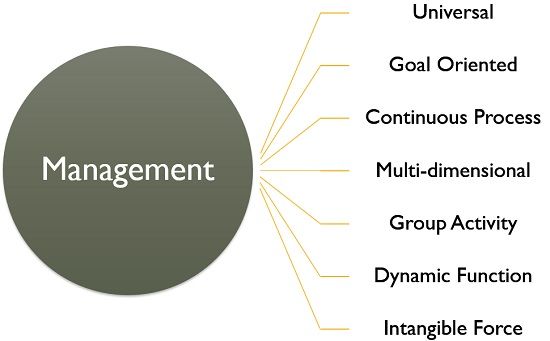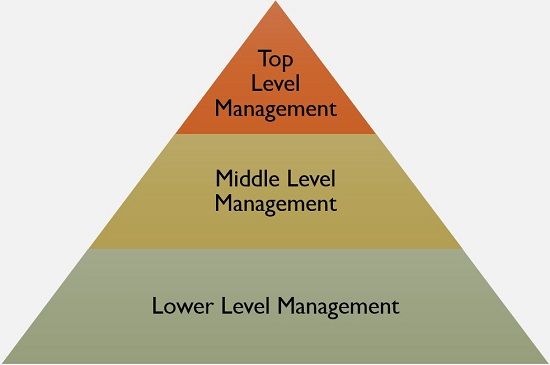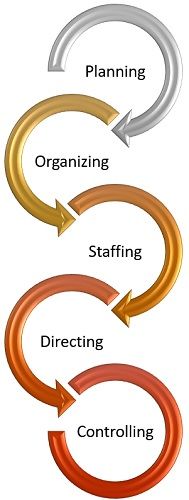Management
Definition: Management can be defined as the process of administering and controlling the affairs of the organization, irrespective of its nature, type, structure and size. It is an act of creating and maintaining such a business environment wherein the members of the organization can work together, and achieve business objectives efficiently and effectively.
Management acts as a guide to a group of people working in the organization and coordinating their efforts, towards the attainment of the common objective.
In other words, it is concerned with optimally using 5M’s, i.e. men, machine, material, money and methods and, this is possible only when there proper direction, coordination and integration of the processes and activities, to achieve the desired results.
Characteristics of Management
- Universal: All the organizations, whether it is profit-making or not, they require management, for managing their activities. Hence it is universal in nature.
- Goal-Oriented: Every organization is set up with a predetermined objective and management helps in reaching those goals timely, and smoothly.
- Continuous Process: It is an ongoing process which tends to persist as long as the organization exists. It is required in every sphere of the organization whether it is production, human resource, finance or marketing.
- Multi-dimensional: Management is not confined to the administration of people only, but it also manages work, processes and operations, which makes it a multi-disciplinary activity.
- Group activity: An organization consists of various members who have different needs, expectations and beliefs. Every person joins the organization with a different motive, but after becoming a part of the organization they work for achieving the same goal. It requires supervision, teamwork and coordination, and in this way, management comes into the picture.
- Dynamic function: An organization exists in a business environment that has various factors like social, political, legal, technological and economic. A slight change in any of these factors will affect the organization’s growth and performance. So, to overcome these changes management formulates strategies and implements them.
- Intangible force: Management can neither be seen nor touched but one can feel its existence, in the way the organization functions.
Precisely, all the functions, activities and processes of the organization are interconnected to one another. And it is the task of the management to bring them together in such a way that they help in reaching the intended result.
Levels of Management
- Top-Level Management: This is the highest level in the organizational hierarchy, which includes Board of Directors and Chief Executives. They are responsible for defining the objectives, formulating plans, strategies and policies.
- Middle-Level Management: It is the second and most important level in the corporate ladder, as it creates a link between the top and lower-level management. It includes departmental and division heads and managers who are responsible for implementing and controlling plans and strategies which are formulated by the top executives.
- Lower Level Management: Otherwise called as functional or operational level management. It includes first-line managers, foreman, supervisors. As lower-level management directly interacts with the workers, it plays a crucial role in the organization because it helps in reducing wastage and idle time of the workers, improving the quality and quantity of output.
The three management levels form the management hierarchy, that represents the position and rank of executives and managers in the chart.
Functions of Management
- Planning: It is the first and foremost function of management, i.e. to decide beforehand what is to be done in future. It encompasses formulating policies, establishing targets, scheduling actions and so forth.
- Organizing: Once the plans are formulated, the next step is to organise the activities and resources, as in identifying the tasks, classifying them, assigning duties to subordinates and allocating the resources.
- Staffing: It involves hiring personnel for carrying out various activities of the organization. It is to ensure that the right person is appointed to the right job.
- Directing: It is the task of the manager to guide, supervise, lead and motivate the subordinates, to ensure that they work in the right direction, so far as the objectives of the organization are concerned.
- Controlling: The controlling function of management involves a number of steps to be taken to make sure that the performance of the employees is as per the plans. It involves establishing performance standards and comparing them with the actual performance. In case of any variations, necessary steps are to be taken for its correction.
Coordination is an important feature of management which means the integration of the activities, processes and operations of the organization and synchronisation of efforts, to ensure that every element of the organization contributes to its success.




Thank you so much for the information
ردحذفThanks for the update
ردحذف